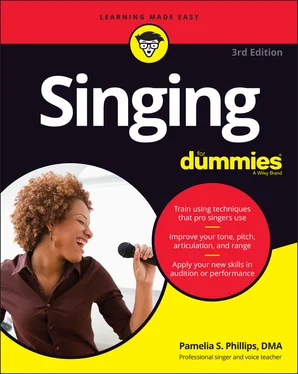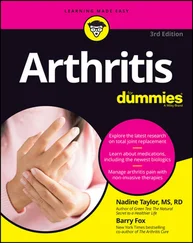1 ...8 9 10 12 13 14 ...19 You want your ankles open and flexible when you’re standing. Sitting in a chair or standing on one leg, move your foot around to feel the flexibility in your ankle. If your ankle feels tight, take your time and move it gently back and forth or in circles to stretch the muscles and release some tension. Move around the other foot or ankle so both are equally released. After you stretch both ankles, notice how they feel. They probably feel open and flexible, as if they can support the weight of your body.
Look at Figure 3-1 to see how the foot and ankle are connected. The ankle isn’t directly over the heel; it’s in front of the heel. If you pretend to sink into your ankles, you feel as if your body is heavier, putting pressure on your ankles and feet. If you visualize a spring (shock absorber) in the ankles, you can feel an opening sensation in the feet and ankles, as if the weight of the body is equally distributed. Go back and forth a few times. Sink into your ankles and then put in the imaginary spring. You want to notice the spring not only when you’re standing, but also when you’re walking.
For singing, you want to engage the entire body in making sound. The legs are your support system, and you want them to hold you up without tightening. Try the following suggestion to discover how to engage your legs.
To feel the legs engage as you sing, use a plié as you take the breath. Plié means “to bend,” and you want to bend your knees as you inhale. This bending helps you feel an opening sensation through your body and down into your legs. As you sing, you can gradually stand back up from the bend. With each new breath, plié again to create the opening sensation in your legs and gradually stand back up. After you practice this way for a few weeks, try singing a song without the plié or bend to see if you can find the same feeling of opening in your legs as you inhale and engage as you sing. Review the skeleton in Figure 3-1; notice the bones in the legs and also the shape of the knees.
 For singing, you don’t want to lock your knees or push your knees back. Locking your knees also locks your lower back, and you want your lower back to open for inhalation.
For singing, you don’t want to lock your knees or push your knees back. Locking your knees also locks your lower back, and you want your lower back to open for inhalation.
Instead, you want to keep your knees released. Released knees aren’t locked — but they’re also not bent. To find the difference between released knees and bent knees, stand and lock your knees by pushing the knee backward until the muscles around the knee lock. Without bending the knees, release the muscles around them. Lock the knees again, and when you release the muscles, bend your knees. Move back and forth from the locked position to the bent position. You want to feel the released position, which is between locked and bent. Bent knees make you a little shorter. Released knees keep you the same height, without tight muscles around your knees.
 To prevent tension in your knees, you can visualize a spring in your knees or pretend that you have oil in your knees, like the Tin Man in the Wizard of Oz, so that they move smoothly. Try using the visual of the spring to feel the difference between weight evenly distributed through the legs and feet and sinking your weight into your legs and knees and creating tension.
To prevent tension in your knees, you can visualize a spring in your knees or pretend that you have oil in your knees, like the Tin Man in the Wizard of Oz, so that they move smoothly. Try using the visual of the spring to feel the difference between weight evenly distributed through the legs and feet and sinking your weight into your legs and knees and creating tension.
Refer again to Figure 3-1 and look at the hips or pelvis. You may think of the hips as what you try to squeeze into your tight jeans. I want you to visualize the pelvis and not those extra 10 pounds you gained last winter. If you’re familiar with the skeleton, you know that I’m talking about moving the pelvis when I say “rock your hips.”
 To find just the right position for your hips, rock back and forward — push your buttocks back and then push them forward. When you rock the hips back, you can feel the tension created in your lower back. That tension isn’t good for singing. Rocking the hips forward helps you feel when they’re too far forward — you feel like your hips are in front of your torso. Instead, you want your hips right underneath your torso, with your tailbone tucked under you.
To find just the right position for your hips, rock back and forward — push your buttocks back and then push them forward. When you rock the hips back, you can feel the tension created in your lower back. That tension isn’t good for singing. Rocking the hips forward helps you feel when they’re too far forward — you feel like your hips are in front of your torso. Instead, you want your hips right underneath your torso, with your tailbone tucked under you.
When you’re confident that you can feel when your hips are centered under you, you can move your hips from left to right. Many people stand with their hips sticking out to the left or right. That posture may be fine for casual conversation, but it’s not helpful for singing. When your hips are off to one side, your back is out of alignment, causing tension. Watching yourself in the mirror, move your hips from left to right or front to back until you feel the centered position underneath your torso. This centered position, neither front, back, right, nor left, is the ideal position for singing.
Because many people sink into their hips, you want to understand what it feels like to lift out of your hips. Lifting out of your hips means that you feel an opening between your hips and your torso. You can intentionally sink into your hips to feel the added pressure on your body. You may feel heavier and slumped when you sink into your hips. To lift out of your hips, feel the spring or shock absorber between your hips and torso, and imagine your torso rising out of your legs.
 The position of your feet affects your hips. As I discuss in the section, “ Putting your feet in position,” earlier in this chapter, you want to position your feet under your hipbones and keep your toes parallel. This position affects not only the muscles in your legs, but also the muscles in your hips and the positioning of the sit bones. The sit bones, or sitz bones, are the bony points of your pelvis that you may feel sticking out inside your buttocks. By positioning the hips and toes in just the right position, you allow the sit bones and hips to stay released and the muscles to stay open. You then have great posture and easy breathing for singing.
The position of your feet affects your hips. As I discuss in the section, “ Putting your feet in position,” earlier in this chapter, you want to position your feet under your hipbones and keep your toes parallel. This position affects not only the muscles in your legs, but also the muscles in your hips and the positioning of the sit bones. The sit bones, or sitz bones, are the bony points of your pelvis that you may feel sticking out inside your buttocks. By positioning the hips and toes in just the right position, you allow the sit bones and hips to stay released and the muscles to stay open. You then have great posture and easy breathing for singing.
The spine is the marvelous curvy set of bones stacked on top of each other inside your body. Figure 3-1 shows the natural curve of the spine. Tension in the spine causes tension for breathing. To lengthen and release the spine, you want to open and lengthen your body from the inside out. Visualize your spine as long and flexible, and feel the distance between your tailbone and your skull. For great posture, you want your tailbone under you and headed to the floor while your skull lifts to the sky. You don’t want to feel a pulling sensation in your body; you want an opening and lengthening sensation. You can visualize space between each bone or vertebrae of your spine. Your spine connects with your rib cage, and you want your spine to lengthen and open with your rib cage.
Balancing your head and shoulders
At the top of the spine is your neck. The neck is supposed to be curved — check out the curve of the neck in the skeleton in Figure 3-1. If you remember the opening and lengthening of the spine from the previous section, you can continue that idea of lengthening through the neck up into the head so that the head balances on top of the spine. Think of the bobble-head dolls that sit on the dash of the car: The body of the dolls doesn’t move, but the head bobs around. You want your head balanced that easily on top of your spine.
Читать дальше

 For singing, you don’t want to lock your knees or push your knees back. Locking your knees also locks your lower back, and you want your lower back to open for inhalation.
For singing, you don’t want to lock your knees or push your knees back. Locking your knees also locks your lower back, and you want your lower back to open for inhalation. To prevent tension in your knees, you can visualize a spring in your knees or pretend that you have oil in your knees, like the Tin Man in the Wizard of Oz, so that they move smoothly. Try using the visual of the spring to feel the difference between weight evenly distributed through the legs and feet and sinking your weight into your legs and knees and creating tension.
To prevent tension in your knees, you can visualize a spring in your knees or pretend that you have oil in your knees, like the Tin Man in the Wizard of Oz, so that they move smoothly. Try using the visual of the spring to feel the difference between weight evenly distributed through the legs and feet and sinking your weight into your legs and knees and creating tension. The position of your feet affects your hips. As I discuss in the section, “ Putting your feet in position,” earlier in this chapter, you want to position your feet under your hipbones and keep your toes parallel. This position affects not only the muscles in your legs, but also the muscles in your hips and the positioning of the sit bones. The sit bones, or sitz bones, are the bony points of your pelvis that you may feel sticking out inside your buttocks. By positioning the hips and toes in just the right position, you allow the sit bones and hips to stay released and the muscles to stay open. You then have great posture and easy breathing for singing.
The position of your feet affects your hips. As I discuss in the section, “ Putting your feet in position,” earlier in this chapter, you want to position your feet under your hipbones and keep your toes parallel. This position affects not only the muscles in your legs, but also the muscles in your hips and the positioning of the sit bones. The sit bones, or sitz bones, are the bony points of your pelvis that you may feel sticking out inside your buttocks. By positioning the hips and toes in just the right position, you allow the sit bones and hips to stay released and the muscles to stay open. You then have great posture and easy breathing for singing.










